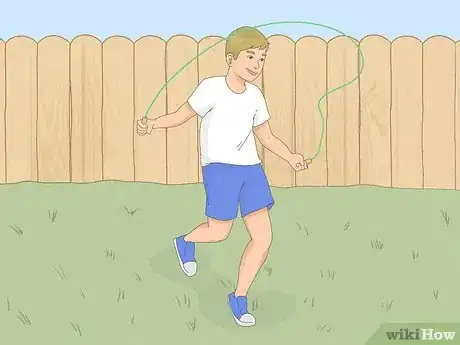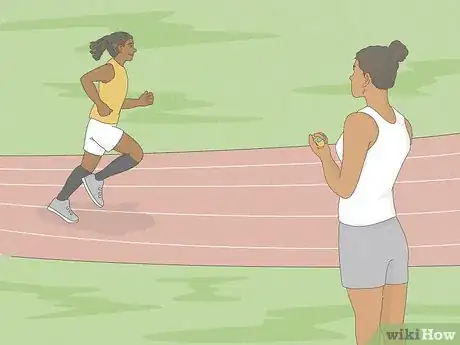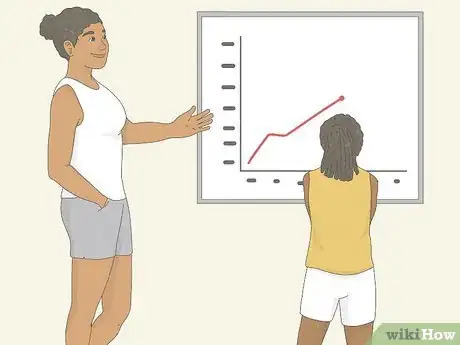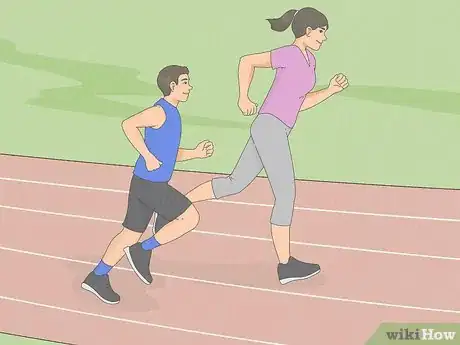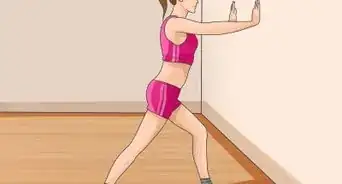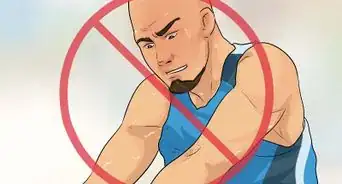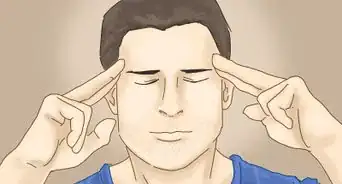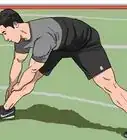This article was co-authored by Francisco Gomez. Francisco Gomez is the Head Coach at the FIT Potato Gym, a training gym established in 2001 in the San Francisco Bay Area. Francisco is a former competitive runner who helps endurance athletes train for major marathons like the Boston Marathon. Francisco specializes in Injury Rehab, Flexibility, Marathon Training, and Senior Fitness. He has a B.S. in Nutrition and Exercise Physiology & Running.
wikiHow marks an article as reader-approved once it receives enough positive feedback. In this case, several readers have written to tell us that this article was helpful to them, earning it our reader-approved status.
This article has been viewed 266,745 times.
Developing a child's speed is a big deal when they’re involved in sports. And many kids would like to run faster just for the sake of it, or to reach a personal goal. Teaching kids to run faster boils down to helping them develop good form and ensuring they have fun while practicing. Keep track of their progress so they stay motivated, and don’t forget to run with them!
Steps
Teaching Good Form
-
1Warm up with jumping exercises. Jumping can help kids build the muscles they need to be strong runners. Before you begin to practice running, lead the kids through a set of jumping jacks or let them use a jump rope.
-
2Check their form while they run in place. Ask kids to run in place as hard as they can for five seconds. Watch their form, and see if they have any weakness. Good sprinting form means:[1]
- Pushing with the front foot.
- Leaning forward so that the feet are behind the hips, and the hips behind the shoulders (also known as the triple extension).
- Keeping the torso vertical.
- Holding the head still and relaxing the face.
- Bending the elbows at right angles.
- Keeping the arms close to the sides as they pump up and down.
- Lifting the front knee high while straightening the back leg.
Advertisement -
3Model proper technique for them. If you notice any issues right away, say so. Then, run in place together with the kids. Mention how you are using correct form. They can watch you to see the right way to do things, and you can watch them to check for improvement.[2]
-
4Help the kids visualize what good running feels like. Giving kids little reminders of what to do while running makes a big difference. For instance, tell the kids to imagine that their feet are pushing their hips forward. This helps them remember that most of the force for sprinting should come from the feet pushing away from the ground.[3]
- You could also tell the kids to imagine they are holding a bird in each hand as they run. That way, they remember to keep their hands closed, but not clenched.
-
5Give them verbal cues. Have the kids practice sprinting. As they run, call out reminders to focus on the aspects of form they need to work on in order to improve. For instance:[4]
- If you have a kid who doesn’t swing their arms wide enough, call out “Hip to lip!” as they run. That will remind them to swing the arms all the way from the sides up toward their face.
- If a kid isn’t lifting their legs enough, call out “Knees up! Knees up!”
Keeping them Motivated
-
1Set a running goal. A kid will really improve only if they want to. Make sure a kid is actually interested in learning to run faster, and talk about why they want to. Then, set an appropriate goal.[5]
- For instance, if a kid plays another sport, like basketball, they might be interested in running faster to improve their performance. Remind them of this occasionally.
- Set goals that focus on improvement rather than winning. Aiming to shave a second off of a 40-yard dash is a more manageable goal than wanting to win the state championship.
-
2Keep track of the kids' progress. For instance, you could keep a graph or chart that records the kids' 40-yard dash times over 6 months. If the kids can visualize how they’ve started to improve, they’ll be more motivated to keep trying and make further progress.[6]
- Make sure to time the kids during drills so you can track their progress.
-
3Don’t push them too hard. Learning to run faster doesn’t happen overnight. It takes patience and lots of practice. If you push kids too hard or try to rush their training, they will get discouraged and not improve. Focus instead on making incremental progress through regular practice.[7]
- Only practice sprinting 3-4 times a week. A kid can get worn out if they practice too frequently.
- Mix up practice sessions so that some days are focused on playing sports that get good running practice in, like soccer, football, basketball, and kickball. This also makes practice more fun!
- Complementary activities, like weight lifting, yoga, and swimming are good for overall athletic development. But to improve running speed, its best to prioritize activities that provide sprinting opportunities.
Making Running Fun
-
1Mix games into practice sessions. Just doing drills over again gets boring and demoralizing. Luckily, it’s easy to work sprinting into a variety of games. For instance, get the kids together and try things like:
- An old-school game of tag.
- A relay race.
- A game of “Red light, green light.”
-
2Make time for playing other sports. Running is a major component of many sports. If the kids get some run time in playing something like soccer, it will help them improve even if it isn’t technically sprinting practice. Plus, mixing things up keeps everyone interested. Sports that have good opportunities for running include:[8]
- Baseball
- Soccer
- Basketball
- Kickball
- Dodgeball
-
3Run with the kid. A coach doesn’t have to just stand on the sidelines. Getting out there and running with the kid gives them moral support, shows them you’re willing to work hard too, and is lots of fun. You can run drills or play games together, for instance. If the kid is interested, you could even run a race together.[9]
Expert Q&A
Did you know you can get expert answers for this article?
Unlock expert answers by supporting wikiHow
-
QuestionHow can I help my child run faster?
 Francisco GomezFrancisco Gomez is the Head Coach at the FIT Potato Gym, a training gym established in 2001 in the San Francisco Bay Area. Francisco is a former competitive runner who helps endurance athletes train for major marathons like the Boston Marathon. Francisco specializes in Injury Rehab, Flexibility, Marathon Training, and Senior Fitness. He has a B.S. in Nutrition and Exercise Physiology & Running.
Francisco GomezFrancisco Gomez is the Head Coach at the FIT Potato Gym, a training gym established in 2001 in the San Francisco Bay Area. Francisco is a former competitive runner who helps endurance athletes train for major marathons like the Boston Marathon. Francisco specializes in Injury Rehab, Flexibility, Marathon Training, and Senior Fitness. He has a B.S. in Nutrition and Exercise Physiology & Running.
Fitness Coach
-
QuestionWhy do we stop when we get tired?
 Michele DolanMichele Dolan is a BCRPA certified Personal Trainer in British Columbia. She has been a personal trainer and fitness instructor since 2002.
Michele DolanMichele Dolan is a BCRPA certified Personal Trainer in British Columbia. She has been a personal trainer and fitness instructor since 2002.
Certified Fitness Trainer We stop when our bodies have used up our fuel supply. One type of energy gets used up in the first 1-3 minutes of vigorous exercise and then there's the next energy supply which lasts longer but is based on getting enough carbohydrates stored up as fuel. Training and good diet will help you extend your energy levels.
We stop when our bodies have used up our fuel supply. One type of energy gets used up in the first 1-3 minutes of vigorous exercise and then there's the next energy supply which lasts longer but is based on getting enough carbohydrates stored up as fuel. Training and good diet will help you extend your energy levels. -
QuestionHow do I become a fast sprinter and a long distance runner at the same time?
 Michele DolanMichele Dolan is a BCRPA certified Personal Trainer in British Columbia. She has been a personal trainer and fitness instructor since 2002.
Michele DolanMichele Dolan is a BCRPA certified Personal Trainer in British Columbia. She has been a personal trainer and fitness instructor since 2002.
Certified Fitness Trainer Sprinting and long distance running are completely different and require different types of training. If you have the time and energy, you can train for both but it may be better to focus more on sprinting during one season, for instance, track season and focus more on distance during cross country season. Be sure to get proper nutrition and coaching for both good sprint technique and long distance technique.
Sprinting and long distance running are completely different and require different types of training. If you have the time and energy, you can train for both but it may be better to focus more on sprinting during one season, for instance, track season and focus more on distance during cross country season. Be sure to get proper nutrition and coaching for both good sprint technique and long distance technique.
References
- ↑ http://activeforlife.com/teach-kids-to-sprint-correctly/
- ↑ http://activeforlife.com/teach-kids-to-sprint-correctly/
- ↑ http://activeforlife.com/teach-kids-to-sprint-correctly/
- ↑ http://activeforlife.com/teach-kids-to-sprint-correctly/
- ↑ http://www.runnersgoal.com/teach-child-to-run-faster/
- ↑ https://www.freelapusa.com/3-simple-ways-to-transform-slow-to-fast/
- ↑ http://www.runnersgoal.com/teach-child-to-run-faster/
- ↑ https://www.freelapusa.com/3-simple-ways-to-transform-slow-to-fast/
- ↑ http://www.runnersgoal.com/teach-child-to-run-faster/
About This Article
To teach kids to run faster, try to make running a fun activity. For example, get them to play a game of tag or have a relay race, which will make running more exciting for them. Running is an important part of many other sports, like soccer or baseball, so try to include activities like these to keep your kids engaged. You should also keep them motivated so they’re focused on running. Encourage them to practice by reminding them why they want to run faster, like to play basketball or beat their friends in a race. Remember not to push your kids too hard, since training to run faster is a long-term project and you don’t want to discourage them. This means you should practice sprinting no more than 3 or 4 times a week so you don’t wear them out. For tips from our Sports co-author on how to improve a kid’s form when they run, read on!
